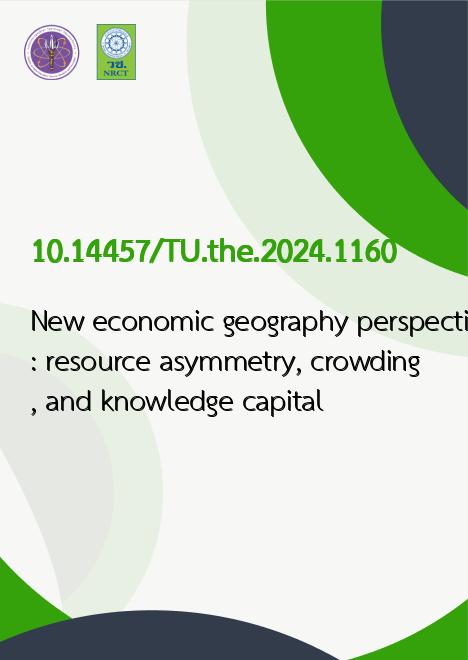
|
New economic geography perspectives: resource asymmetry, crowding, and knowledge capital |
|---|---|
| รหัสดีโอไอ | |
| Title | New economic geography perspectives: resource asymmetry, crowding, and knowledge capital |
| Creator | Luoluo Gu |
| Contributor | Monthien Satimanon, Advisor |
| Publisher | Thammasat University |
| Publication Year | 2567 |
| Keyword | Regional economic disparities, Asymmetric resource endowments, Urban congestion effects, Knowledge spillovers, New Economic Geography (NEG), Industrial agglomeration, Capital flows, Labor mobility, Regional coordinated development, Spatial economic models, ความเหลื่อมล้ำทางเศรษฐกิจระดับภูมิภาค, การมีทรัพยากรเริ่มต้นที่ไม่สมมาตร, ผลกระทบจากความแออัดของเมือง, การแพร่กระจายขององค์ความรู้, ภูมิศาสตร์เศรษฐกิจแนวใหม่, การกระจุกตัวของอุตสาหกรรม, การไหลของเงินทุน, การเคลื่อนย้ายแรงงาน, การพัฒนาภูมิภาคอย่างประสานกัน, แบบจำลองเศรษฐกิจเชิงพื้นที่ |
| Abstract | This dissertation investigates the underlying mechanisms driving regional economic disparities in developing economies, with a particular focus on asymmetric resource endowments, urban congestion, and knowledge spillovers. By extending the theoretical foundations of New Economic Geography (NEG), this study develops the Asymmetric Endowment Linear Capital (AELC) Model to capture the effects of uneven resource distribution on capital flows and industrial agglomeration. Additionally, an expanded Footloose Entrepreneur (FE) Model is introduced to analyze the impact of urban congestion on skilled labor mobility and regional competitiveness. Empirical analyses further examine the role of knowledge spillovers in shaping regional economic trajectories, with China serving as the primary case study. The findings reveal that asymmetric resource endowments contribute to persistent economic divergence, as resource-rich regions attract greater investment while resource-poor areas face structural constraints. Urban congestion presents a dual challenge, driving economic concentration while simultaneously impeding labor mobility and increasing regional imbalances. Furthermore, knowledge spillovers exhibit highly uneven effects, reinforcing disparities between innovation hubs and peripheral regions.Based on these insights, this study offers a set of policy recommendations aimed at mitigating regional inequalities, including targeted investment in infrastructure, enhanced mechanisms for knowledge diffusion, and strategic urban planning to alleviate congestion effects. While this research is centered on China, its theoretical contributions and empirical findings have broader implications for regional development policies in other emerging economies. By integrating advanced theoretical modeling with empirical validation, this dissertation provides a comprehensive framework for understanding and addressing spatial economic disparities in an era of rapid globalization and technological change. |